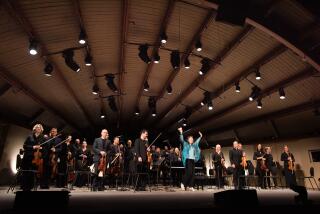Is There a Secret in the Bach Partita?
- Share via
In his new novel, “Gould’s Book of Fish,” Tasmanian writer Richard Flanagan memorably labels Vivaldi’s “The Four Seasons” as “that vile anthem of contemporary retailing.” Is Bach’s Partita in D Minor for solo violin, with its extraordinary chaconne movement at the end, next in line to subliminally convince shoppers about the quality of high-end goods? Played in a pretentious restaurant, perhaps the partita might now put diners in the mood to order the older pinot noir.
That seems the fate of the very curious musicological sleight of hand that pits some of Bach’s death-haunted chorales with the D-Minor Partita. The somber ECM recording “Morimur” by the Hilliard Ensemble and violinist Christoph Poppen, based upon arcane new Bach research, has been jostling with trivial crossover bestsellers on the Billboard classical charts for the last 29 weeks, at one point climbing as high as No. 4. It has become this season’s background music of choice for quiet reflection, Sunday brunch and nosing around expensive antiques.
Even so, it is hard to entirely dismiss the “Morimur” phenomenon as simply a mindless musicological gimmick, which, in part, attempts to find a secret program in the partita that relates it to the Latin phrase “In Christo morimur” (we die in Christ). The music remains great. The performers are compelling. And heard live Sunday evening at UCLA’s Schoenberg Hall, where Hilliard and Poppen began their “Morimur” tour, it was quite beautiful.
The thinking behind the project, as I understand it from the muddled notes on the recording (which were reprinted in the program), is that Bach had the death of his first wife, Maria Barbara, in mind when he wrote the D-Minor Partita. And the composer, ever fascinated with numerology, left hidden codes about death in the partita that relate it to certain chorales found in his cantatas and passions.
To emphasize these findings, German musicologist Helga Thoene has extracted fragments of chorale melody here and there and elastically altered the rhythms so that they might be sung along with the chaconne movement.
But once you begin the numbers game with Bach’s music, you can find just about anything you look for if you are clever enough. And if you allow yourself enough flexibility, the laws of counterpoint will help you fit the most surprising things together. P.D.Q. Bach has made a wonderful career out of doing just that.
Bach, of course, may well have been mourning his wife while he wrote the D-Minor Partita, and it is not unbelievable that bits of the chorale melodies were consciously or subconsciously floating about in his head at the time. But he left the music to speak for itself, and it has for centuries, in a wide variety of contexts. Would Ferruccio Busoni, for instance, have felt quite so entitled to make his magnificent virtuosic piano transcription of the chaconne if he had had to worry about such emotionally confining hidden subtexts? When it is not Bach but a manipulative musicologist telling us what to think, she limits, not expands, our horizons.
The performers take a peculiar middle ground in all this. Three of the four men in the Hilliard Ensemble, joined by soprano Monika Mauch, sing “relevant” chorales between movements of the first four movements of the partita, then they all come together for the chaconne. Just how relevant these chorales are, however, is not spelled out. No texts are offered, and even the sources of the chorales are not specifically identified (Bach often reused the same chorales, with different harmonizations, in his cantatas and passions). After spending some time with a chorale book and the recording, identifying the sources, I found myself no further enlightened and quit.
In live performance, the Hilliard and Poppen are unrelievedly solemn in demeanor--the violinist grim as a mortician on stage. Yet they are flamboyant interpreters. The singers brought an interpretive character and expressivity to the chorales that is rare and winning. However stiff and expressionless he stood, Poppen played with a dramatic urgency in which early music performance practice verged on Romantic excess. And however dubious Thoene’s musicology, she has talent as a composer, because on purely musical terms the descant she adds to the chaconne works.
It was not, however, so easy to overlook the pretense of the first half of the program, “Revelations.” Here the four men of the ensemble mixed Renaissance music by Nicolas Gombert and Jacquet de Mantua with new pieces by Joanne Metcalf and Karen Thomas, which were a kind of ye olde musick with added dissonances. The plan was to extract from religious allegory an erotic revelation or two on the name Maria. That didn’t happen, but the singing, at least, was stunning.
More to Read
The biggest entertainment stories
Get our big stories about Hollywood, film, television, music, arts, culture and more right in your inbox as soon as they publish.
You may occasionally receive promotional content from the Los Angeles Times.











